|
Indian Grey Hornbill
This is an article about the Indian Grey Hornbill (Ocyceros birostris) breeding behavior observed at the bio diversity park in the Residency area in Indore city.
I have been observing the Indian grey hornbill since last 5 years in the Residency area of Indore. I always get mesmerized when I see these birds, firstly due to their very peculiar casque (horn) over the bill and secondly due to their undulating type of flight.
The Residency area in Indore is full of old Fig trees like Pipal, Jamun, Banyan, Gular etc. and hence attract the hornbills all the time as these figs comprise most of their diet. I used to see them mostly in morning time moving high up in the canopy as they are mostly arboreal in nature.
The IGH Breeding period coincides with the ripening of fruits in all the fig bearing trees, which is from March to May-June.
During this period there is ample  food available in the form of fruits of these trees which helps the parents to fulfill the demands of the growing chicks.
Outside their breeding season these birds are frequently seen in morning and evening feeding and indulging in various social interactions like bill grappling, aerial jousting and erratic chases in the higher canopy of trees.
This time I will like to share with you my experience with the IGH bill nesting behavior recorded and unveiled by using a camera.
I had watched a natural hole on a Gulmohar tree which a hornbill pair had used for nesting purposes in last season. This time with the help of the forest department, Â a CCTV camera, capable of zooming in and out was installed at 5 meters away from the nest to record its whole breeding cycle almost for a period of 3 months. Â A Movie called ?UDAN? was made based on the important footages obtained from the 24X7 recording which was later inaugurated by the Chief Minister of Madhya Pradesh.
I will like to share briefly about the general breeding behavior of the IGH.
IGH nesting is very unique. When it is time to lay the eggs, the female hornbill enters the hole of the tree trunk and does not step out into daylight again, until it hatches the eggs and the babies are at least one and half month old, which means she remains in the nest cavity for 60 to 65 days.
The Female starts to seal the nest cavity once she enters inside. Only a narrow slit of size 3-4 cm by 7-8 cm remains open, from where the Male feeds the Female. The materials used to prepare the wall of the nest cavity are mud, fruit pulp and her own droppings. Â The Female now solely depends on the Male for her diet. The Male fetches fig and berries from nearby trees and feeds the female, approximately once in an hour throughout the day. Most of the feeding took place early in the morning. The Male carries 5-8 berries and 1-2 insects in his mouth in one go and regurgitate them one by one into the female beak by clinging himself to the nest.
Once inside the nest, the female lays the eggs and incubates them. Soon the chicks come out of the egg. At the same time the female also undergoes complete moult, by shedding all her feathers. Â This is a real vulnerable time for the family as the female bird cannot fly and cannot feed the chicks, the family is totally dependent on the male bird. If something happens to the male bird and if he dies, then the entire family can die due to starvation. Â
During the nesting the male bird feeds the female and the chicks with a variety of fruits, and also small insects, grasshoppers, lizards etc. It travels long distances in search of food. The fruits are held in its throat and when it reaches the nest, Â it regurgitates the fruit one by one from its pharynx to its beak and feeds. The female does not come out at all, except for putting its beak out.
When the chicks are sufficiently grown the female breaks open the nest and comes out and both feed the young ones.
These birds use the same tree and nest for  future breeding also and come back to same point in their next breeding cycle.
The camera study for complete 3 months of the Hornbill nesting was done first time ever and it proved many of the points which the scientists have written in their journals over the years.
The main findings that come out of the CCTV Camera study were:
Constituents of Diet : The major plant species that constitute the food of the hornbills during the nesting period was Pipal, forming roughly 40% of its diet, Banyan, which constitutes 20% of its diet, around 20% was insects and rest 20% other fruits. Interestingly in the video the Male hornbill Bird was seen feeding pieces of dry Chappaties and biscuits which was altogether a new finding.
Moulting of feathers by the female : The Female has seen dropping many feathers from inside the nest which confirms the theory that she sheds her old feathers and comes out with new feathers. We have collected those feathers and sent to BNHS and got confirmation from the scientists of BNHS, Mumbai, regarding the same.
Closing of wall by the Chicks : It was unique that the chicks did close the wall once again after the female had left the hole leaving a small slit open as their mother has done earlier with the help of mud, saliva and fruit pulp. It was amazing to see them closing the hole and I kept pondering that who had taught them to do so and how.
Study of Excreta: The excreta collected and examined contained undigested seeds of the various fruits and berries delivered to her by the male hornbill. I recorded somewhere close to 20 different types of seeds after identification. Some undigested parts of insect?s body were also collected beneath the tree where the nesting was done . Undigested body parts like feathers, eyes etc. of grasshoppers and other insects were collected which the Male had brought to provide the nutritious and protein rich diet for the chicks.Â
Use of Bark : The female accepted numerous bark pieces provided by the male hornbill. Some bark pieces were thrown out by the female later, these bark pieces were belonging to different trees species. I collected many such ejected bark pieces with fresh excreta on it. These dry bark pieces are used to absorb much of the water content from the fecal matter. They probably play a vital role in maintaining humidity inside the nearly sealed cavity nest and providing a cleaner environment inside the nest.
Birds visiting the Nest: The Rose ringed parakeets were the most curious ones and frequent visits were made trying to peep inside the cavity. The common Myna and Oriental magpie robin were also recorded to visit the nest in the footages. The Squirrels were also keen in looking inside the nest at all the time and used to visit the nest many times in a day.
Interesting activity of chicks was also recorded. They did not want to come out of the hole, because they find it very comfortable inside the nest, with parents feeding them;  but the parents entice them by holding the food in their beak and encouraged them to come out of the nest to fetch it and face the world.
An important message has come out of the complete observation of the IGH nesting. The female trusts the male blindly and the male does not commit breach of trust! A lesson to the mankind!
The Movie of their life cycle was prepared with the help of funding from the M.P. Ecotourism board and was inaugurated by the Chief Minister at the State Wildlife Board Meeting. The 11 minute movie was screened at different cinema halls in Indore during intervals of regular movies and distributed for viewing in many schools of Indore.
Ajay Gadikar
Ornithologist, Indore
Deccan Herald published an article about IGH nesting. You can read the article at the link
http://www.deccanherald.com/content/493143/a-transition-natural-concrete.html
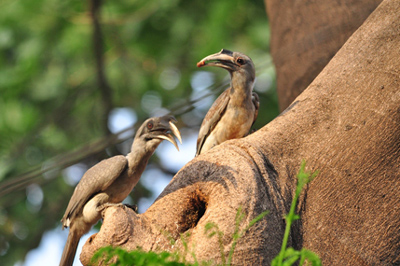
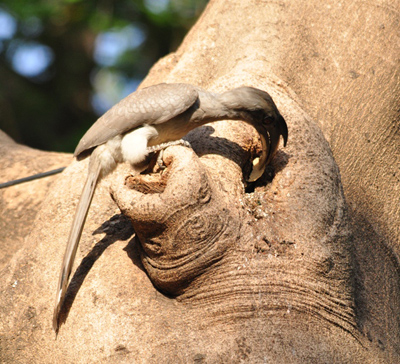
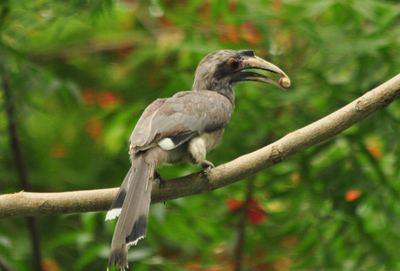
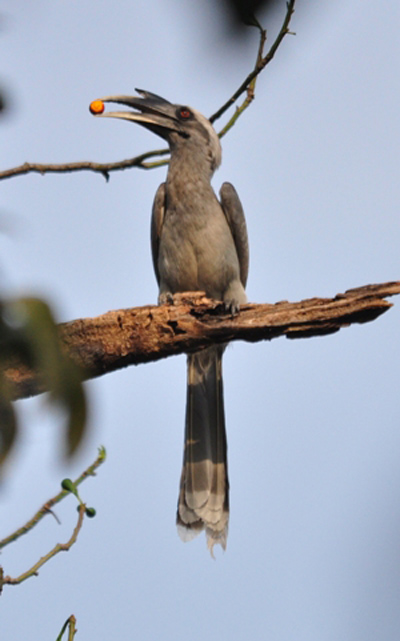
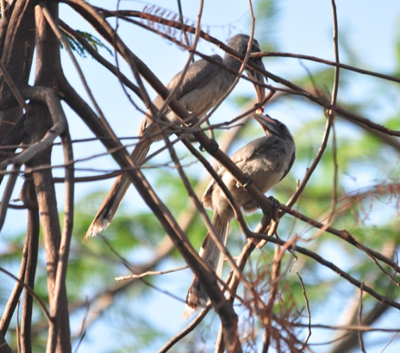
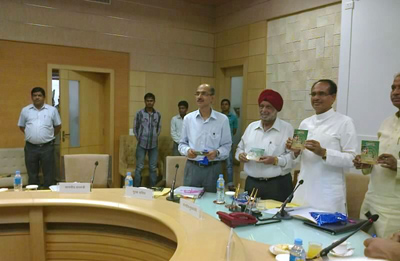
.jpg)
|